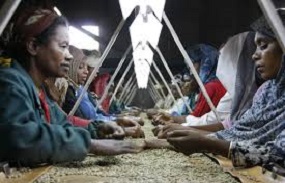Ethiopia’s Economic Journey: Reflecting on the Past, Navigating the Future
BY ERMYAS T. AMELGA – Ethiopia stands at a significant crossroads in its economic development. As the country continues to pursue a path toward growth and modernization, it is essential to reflect on the historical journey that has shaped its economy.
Understanding this evolution — from the reforms of Emperor Haile Selassie, through the socialist experiment under the Derg, to the recent efforts at liberalization — provides valuable insights into the challenges and opportunities that lie ahead.
Foundations of Ethiopia’s Modern Economy (1930-1974)
The seeds of Ethiopia’s modern economic transformation were planted under Emperor Haile Selassie I, whose reign marked the beginning of the country’s shift from a traditional agrarian society to a more diversified economy.
Key to this transformation was the introduction of the Ethiopian Birr in 1945, which replaced the Maria Theresa thaler and asserted Ethiopia’s monetary independence. The establishment of the National Bank of Ethiopia (NBE) in 1963 further cemented this sovereignty, providing the country with a central institution to manage its financial affairs and support economic growth.
During this period, Ethiopia adopted an open economic model by African standards, encouraging foreign investment in agriculture, manufacturing, and infrastructure. Initiatives to modernize the agricultural sector — Ethiopia’s economic backbone — alongside infrastructure development and the establishment of a stock exchange, demonstrated the country’s commitment to integrating into the global economy.
The Impact of Italian Occupation: Disruption and Development (1936-1941)
The Italian occupation of Ethiopia from 1936 to 1941, though aimed at exploiting the nation’s resources, had a dual impact. While the occupation brought economic disruption, displacement, and hardship, it also resulted in infrastructure projects that would later aid Ethiopia’s recovery. Roads, bridges, and urban infrastructure, initially intended for colonial exploitation, laid the groundwork for post-war economic growth.
In the short term, the occupation’s effects were devastating, with significant disruptions in agriculture, trade, and local industries. However, the infrastructure left behind and the introduction of new agricultural practices eventually contributed to Ethiopia’s long-term development, illustrating a complex legacy of both harm and unintended benefit.
Post-War Economic Expansion and Modernization (1941-1974)
After World War II, Ethiopia entered a period of economic reconstruction under Emperor Haile Selassie. The focus was on rebuilding the agricultural sector, particularly coffee production, which became the cornerstone of economic recovery and export revenue. Infrastructure development, such as expanding the road network and building hydroelectric plants, played a crucial role in sustaining growth and connecting rural areas to urban centers and markets.
Investments in education and the creation of state-owned enterprises (SOEs) marked an effort to diversify the economy beyond agriculture. While agriculture remained dominant, these efforts laid the groundwork for industrial growth and economic modernization.
The Derg Era: Command Economy and Decline (1974-1991)
The Derg’s rise to power in 1974 led to a dramatic shift toward a command economy, characterized by widespread nationalization, economic isolation, and central control. This period was marked by inefficiency, declining agricultural productivity, and severe economic decline. The Derg’s policies, including land reforms and the creation of state-owned enterprises, stifled private enterprise and innovation, leading to economic stagnation.
Alignment with the Soviet Union and the adoption of a command economy model further isolated Ethiopia from global markets, depriving the country of essential trade relationships and foreign investment. The devastating famine of 1984-1985, exacerbated by economic mismanagement and political conflict, highlighted the failure of the Derg’s economic policies and contributed to its eventual downfall.
Transition to a Free Market Economy (1991-Present)
The fall of the Derg in 1991 marked a critical turning point as Ethiopia embraced free-market principles and embarked on significant economic reforms. Guided by the Structural Adjustment Program (SAP) and supported by international financial institutions, Ethiopia moved to liberalize its economy, privatize state-owned enterprises, and attract foreign investment.
These reforms revitalized key sectors such as agriculture, manufacturing, and services, contributing to renewed economic growth. However, challenges like persistent poverty, inequality, and vulnerability to external shocks remained significant hurdles to sustainable development.
A Decade of High Growth and Ambitious Plans (2005-2015)
Between 2005 and 2015, Ethiopia launched an ambitious Growth and Transformation Plan (GTP) aimed at achieving middle-income status by 2025. The plan focused on infrastructure development, agricultural modernization, and social investments. Projects like the Grand Ethiopian Renaissance Dam (GERD) symbolized the country’s aspirations to drive growth and regional integration.
While the GTP achieved notable progress, particularly in infrastructure development, it also underscored the challenges of rapid growth, such as inflation, currency depreciation, and social inequality. The need for more inclusive and sustainable development strategies became increasingly apparent.
The Current Landscape and the Path Forward (2015-Present)
In recent years, Ethiopia has pursued a comprehensive reform agenda to address structural challenges and promote a more diversified economy. Liberalization of key sectors, such as telecommunications and banking, and efforts to attract foreign investment have been central to this strategy. However, Ethiopia must confront significant challenges, including political instability, youth unemployment, and income inequality.
To sustain economic growth, Ethiopia must ensure that reforms are inclusive and benefit all citizens. Promoting a stable political environment, investing in human capital, and pursuing sustainable development practices will be critical for building a resilient and prosperous future.
Conclusion: Charting Ethiopia’s Economic Future
Ethiopia’s economic journey is a testament to its resilience and adaptability in the face of adversity. From the foundational reforms under Emperor Haile Selassie to the complex legacy of the Derg era and the recent push for market liberalization, Ethiopia’s history offers important lessons for its future. The road ahead will require sustained commitment to reform, strategic investments in human capital, and a focus on inclusive growth.
By embracing these principles, Ethiopia can navigate the challenges of the present and build a future where economic opportunities are accessible to all its citizens, ensuring a stable and resilient path forward.
The full article can be accessed HERE;
 EDITOR’S NOTE: The writer, Mr. Ermyas T. Amelga is an Ethiopian economist and entrepreneur and the founder of Zemeb Bank S.C.
EDITOR’S NOTE: The writer, Mr. Ermyas T. Amelga is an Ethiopian economist and entrepreneur and the founder of Zemeb Bank S.C.
